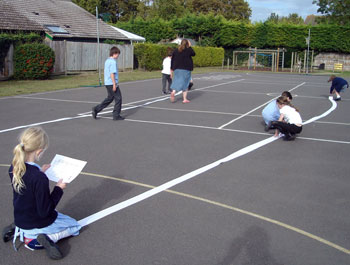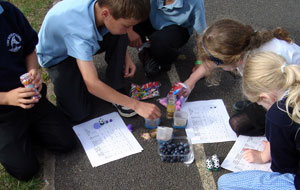Or search by topic
Number and algebra
Geometry and measure
Probability and statistics
Working mathematically
Advanced mathematics
For younger learners
Make Your Own Solar System



- Project
- Teachers' Resources
The following downloadable sheets may be useful:
Can you make a model of the solar system, so that both the sizes of the planets and their distances from each other and the Sun are all to scale?
This is not a straightforward problem, since although the planets are very big, their diameters are much, much smaller than the distances between them and the Sun.

Getting started
Collect the following resources:
- a toilet roll (unused and complete!) for each group of students
- a large blow-up ball (the bigger the better, to represent the Sun)
- a range of spherical (or nearly spherical) objects, ranging in size from a mustard seed up to small to medium-sized balls
- a large space - big enough to take an unrolled toilet roll, preferably indoors, since even a very slight breeze will move the toilet roll and small objects on it
The unrolled toilet roll will represent the distance from the sun - to be placed at one end - to the outermost planet.
Hint: Pluto is now classified as a dwarf planet rather than a planet. If you include it, you increase the distance you need to work with from 4,500 million km to 5,900 million km. It is probably best not to include it!
Scaling the distances in the solar system

Use this table to help you decide how you are going to make your model. You could:
- make each piece of toilet paper a particular distance, say, 20 million km
- divide the total distance between the Sun and Neptune by the number of pieces in your toilet roll
- divide the total distance between the Sun and Neptune by the length of the toilet roll
Or you may have your own ideas about how you want to scale your model.
Mark where each planet will go on the toilet roll.
Scaling the planets
Using the data in the table, start by putting the planets in order of size. Then pick objects to represent each planet.
Put the objects in the right places on the toilet roll.
- Which is the biggest planet?
- Which is the smallest?
- Which planets are closest together?
- Which are furthest apart?
Improving your model
If you wanted to use the same scale as you used for your toilet roll solar system to make models of the planets, how big would the biggest planet be? How big would the smallest be? Is this a practical scale for a model solar system?
If you made the smallest planet so that it had a diameter of 1cm, how big would the distance from the sun to Neptune need to be? How about if you represented the smallest planet with a mustard seed?
If you can, decide on a scale which will allow you to represent both the distances and the diameters of the planets. Find a long enough roll of paper (perhaps two or more toilet rolls stuck together), then either find suitable objects for each of the planets, or make them from modelling clay, papier mache, or similar.
If there isn't room to do this, you will need to agree that your planets and distances have to have a different scale. So how will you scale the size of your planets?
If you make your own planets, find out what colour they appear to be, and paint them.
Working with your model
Make a colourful poster for each planet: more information about the planets.
You could include things like:
- how far it is from the Sun
- its diameter
- its mass
- any unusual features
- the number of moons, and their names if there aren't very many
- whether it is a rocky planet or a gas giant
- if it has an atmosphere, what is it made of
- how long its 'year' and its 'day' are
- its lowest and highest surface temperatures, and whether one side is always shielded from the Sun or not
- some calculations:
- how strong is its gravity, how high could you jump
- how fast would a rocket have to go to escape from its gravitational pull
- how long would it take an email to get from Earth to the planet
- how long it would take a rocket to get from Earth to the planet
- the problems humans have have to overcome if they were ever to establish a colony on the planet
Or you may have other things you want to find out about the planets which you could include.
With thanks to the 'Don't Try This At Home' Club Fowlmere Primary School, Cambridgeshire for letting us visit them and take photos.
Related Collections
You may also like
A Brief History of Time Measurement
Noticing the regular movement of the Sun and the stars has led to a desire to measure time. This article for teachers and learners looks at the history of humanity's need to measure things.
Observing the Sun and the Moon
How does the time of dawn and dusk vary? What about the Moon, how does that change from night to night? Is the Sun always the same? Gather data to help you explore these questions.
Pinhole Camera
Make your own pinhole camera for safe observation of the sun, and find out how it works.

